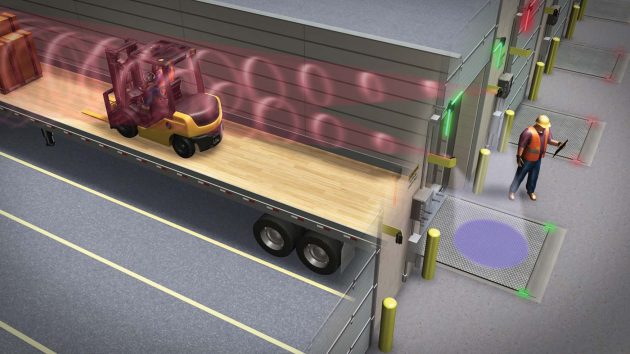
Let there be light: New devices to make docks safer
By Chad Dillavou
Industry Operations Manufacturing manufcaturing Rite-Hite TechnologyUpdated products incorporate sensors, LED lights, alarms and interlocking controls.

A sensor-based system projects a blue light onto the leveller when activity is detected inside a trailer. PHOTO: RITE-HITE
As one of the busiest areas in any facility, it’s no surprise that almost 25% of all industrial accidents take place in the shipping and receiving area. Potential hazards are growing as loading docks try to keep up with more frequent fulfilments.
At a minimum, basic interior and exterior light systems deliver timesaving communication. According to a survey conducted by HR Magazine, 48% of employees said confusing direction led to an average of 40 minutes of lost productivity per day. All of this lost time leads to potential accidents, missed shipments and longer delivery delays.
Many updated dock safety products incorporate sensors, LED lights, audible/visual alarms along with interlocking controls to minimize human error. Products are offered as standalone options or can be added as a retrofit. From inside the building to outside on the drive approach, these breakthrough solutions help to implement comprehensive safety protocols into the dock operations of any facility.
One of these solutions is a sensor-based system that projects a blue light onto the leveller whenever activity is detected inside a trailer. Workers are alerted that a forklift, pallet jack or pedestrian could be exiting at any moment. Complementing commonly implemented blue safety lights, this solution allows pedestrians additional warning time to react to potential hazards. In some instances, it integrates with an advanced control box to keep the vehicle restraint locked until activity inside the trailer stops, ensuring the truck does not pull away with a pedestrian or forklift inside.
Trigger alarms
Dock workers have to think about safety outside on the drive approach. Most collisions here typically involve a semi-tractor trailer rather than a forklift. “Struck-by” and “caught-between” injuries are real risks loading dock workers face daily.
Given ambient noise and the distance between a loading dock and the engine of a semi-tractor trailer, which can be in excess of 21 metres, inattentive or distracted dock workers may not hear a trailer backing toward them until it’s too late. OSHA has even identified semi-tractor trailers as the second leading cause of backover fatalities in the US. However, these accidents are not uncommon in Canada, or the rest of the world. In fact, New Zealand recently recommended the incorporation of reversing alarms and cameras in semi-tractor trailers while France introduced an increased dock bumper size to create a “refuge zone” between tractor trailer and building wall.
In Canada, The Globe And Mail reports from 2011 to 2015 workers in transportation and storage were the second most likely to suffer traumatic injuries resulting in death. The five-year total of 326 was only surpassed by the 467 fatalities in the construction industry. While these numbers are staggering, taking the proper safety precautions can prevent approximately 70% of these fatalities and associated costs.
One such precaution incorporates vehicle restraints with external sensors to trigger audible and visual alarms that help alert outside dock workers that activity in the drive approach has been detected.
Additionally, outside cameras with an interior monitor provide real-time views of vehicle restraints to ensure they’re properly engaged. This reduces processes that place personnel out on the busy drive approach. Some options allow for interchangeable views between two of three general locations: rear impact guard (RIG), rear wheel and nose of the trailer in the case of those being spotted. The views are available to in-plant loading dock workers on advanced dock controls or through a standalone screen. This system helps to keep boots off the ground, which is the best defence against back over accidents.
The most basic light communication systems are still key. Red/green interior and exterior dock lights, which indicate a trailer is locked and safe to enter are the most standard and simple solutions for communication and safety. However, with more frequent shipments, these interior lights are not always visible as stacked pallets obscure a lift driver’s view of them on the control panel.
Enhanced solutions to this everyday occurrence have been developed with the help of highly visible LED lights placed in the upper corners of dock doors. These elevated lights allow forklift operators to determine the red/green signal even when control box lights are not visible. This same principle extends onto the leveller. LED lights placed in the rear corners of the leveller communicate to forklift operators inside the trailer that it’s safe to securely load/unload.
Finding the right system that incorporates dock equipment with sensors and LED lights, audible alarms and real-time video cameras minimizes risks in a traditionally dangerous place, and helps to put any manufacturer on the path to a safer future.
Chad Dillavou is a product manager at Rite-Hite, a manufacturer of loading dock equipment, industrial doors, safety barriers and industrial fans based in Milwaukee, Wis. Visit www.ritehite.com.
This article was published in PLANT Magazine’s May-June 2019 print issue.
